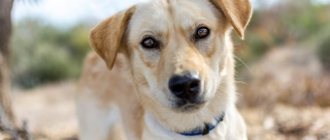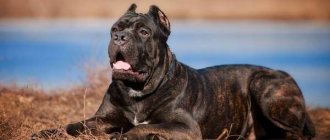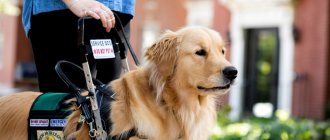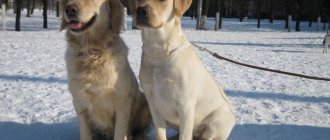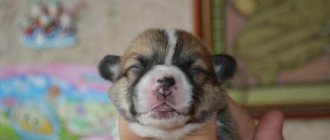This article contains all the information about who mestizos are and why it is sometimes better to have them. All the nuances that breeders should take into account before crossing a Labrador with any other breed are also indicated.
If you are going to buy a pet that will be very similar to a Labrador, but at the same time the price will be much lower, then you should pay attention to mestizos.
Mixed breeds are the result of a mixture of two different dog breeds.
At the same time, you should not think that puppies born from different parents will have any defects. On the contrary, such individuals take all the best qualities from their parents.
Only purebred individuals are crossed.
Sometimes even winners of various exhibitions.
The most popular type of mestizos at the moment is a cross between a Labrador retriever and a husky, husky or shepherd dog.
What is the breed standard
A dog breed standard, including a Labrador, is a set of characteristics and physical attitudes for an animal that must be preserved for the purity of the breed and the health of the breed.
The standard was approved in 1987 for two varieties of breeds - American and English Labrador. The standard includes not only the exterior, but also the characteristics of the dog’s temperament.
In dog breeding, it is customary to focus on the English standard of the Labrador breed, because it was adopted somewhat earlier than the American one.
The American breed standard is not much different from the English one, this mainly concerns the temperament of the dogs - the “Americans” are more active than the “English”.
Mini Labradors, or a few words about commercial breeding
Today you can often find advertisements for the sale of dwarf Labrador puppies. For experienced breeders, such things are puzzling.
After all, purebred dogs recognized by the English and American clubs have certain standards, and dogs that do not meet generally accepted international standards are disqualified. However, the fact remains that for some a mini Labrador will become a good friend who does not require special conditions of detention.
What are mini Labrador dogs and where do they come from? As a rule, puppies of this type are the result of crossing two short Labradors or dogs that are not purebred. As a rule, the breeder is not very worried about the purity and quality of the breed, he is only interested in making money, because the demand for dogs is much higher: they cost less, eat less, and do not take up much space.
The official description of the Labrador Retriever breed contains exact dimensions - height at withers 56-57 cm and weight up to 45 kg. Even if the dog is more than 2 cm shorter, it may be disqualified and not allowed to breed. The reason for this is multiple health problems, ranging from dysplasia to low life expectancy.
To date, no organization in the world has recognized the Mini Labrador breed; not a single Labrador Retriever standard contains information about the mini version of this breed. Therefore, those who want to buy such a dog need to remember: a cheap puppy can result in large expenses for treatment, and mental disorders are dangerous for the owners themselves.
What does a dog look like according to the RKF?
- Torso. The Labrador's back line should be straight, the croup should be short and strong. There should be no hunchbacks. Labradors have a wide chest, barrel-shaped ribs, well-defined withers, and a medium-length tail, wide at the base and tapering towards the end. It’s hard to imagine Labradors without such an otter-like tail. It should be located horizontally to the lower back. In the active state, it can be slightly raised, but a crescent shape or bend behind the back is not allowed.
- Head and muzzle. Labradors have a large and massive skull, which stands out a little from the whole image. The cheeks are dry, not fleshy. The muzzle is slightly wide, not too long. Narrow or short is not allowed. The nose is large, with wide nostrils. Labradors' ears are in a hanging position and slightly behind the head. Should not be too long or heavy. The eyes have a friendly and intelligent appearance; only dark shades and medium-sized irises are allowed. The bite is scissor-shaped and the upper jaw completely covers the lower jaw. The neck is dry, long and without folds.
- Front and hind limbs. The general appearance of the limbs is strong and muscular, located parallel to each other. The length of the forelimbs is equal to half the length of the animal at the withers. The pasterns are in the same plane as the forearm, the hock joints are clearly visible.
- Wool. Labradors have short hair, often short. It is hard to the touch, with a dense and dense undercoat underneath. The main feature is water resistance.
Expert opinion Semyon Kirillovich Kozhevin Expert dog handler. Ask a question to an expert “I think the main feature is the tail. This is what they look at, this is due to its specific shape. Another distinctive feature is the ears. They are located as if behind the head. It is also easy to check how purebred a Labrador is by looking at its undercoat. It is especially thick in this breed and also performs water-repellent functions. Well, basically Labradors look like strong and muscular dogs, their movements are smooth, cutting through the air.”
Crossbreed options
Mixed husky and shepherd, pit bull, wolf, malamute, pug and others
Currently, quite productive breeding work is being carried out to create mixed breeds of retrievers and other dog breeds. Below are descriptions of the external and behavioral characteristics of various Labrador mixes.
With shepherds
Labrador and Shepherd mixes are fairly large dogs that come in a variety of colors. Adults weigh approximately 45-50 kg. To obtain a mixed breed, German, Caucasian or East European shepherd dogs are chosen.
Labrador/German Shepherd mix
Labrador and shepherd mixes are quite active, playful and good-natured animals. Such pets will make excellent companions. After all, due to their timidity, they are not able to perform security functions.
Dogs will need to be fed special hypoallergenic food, since these animals are prone to allergies to certain foods, as well as indoor plants.
With a Dalmatian
Externally, mixed breeds of a retriever and a Dalmatian resemble spotted Labradors. True, they weigh a little less. In addition, nature has endowed such dogs with longer limbs.
Representatives of a crossbreed are usually distinguished by the following character traits:
- smart,
- unperturbed,
- charismatic,
- friendly.
They harmoniously combine the qualities of a guard and a companion.
With a poodle
The Poodle mix, otherwise known as the Labradoodle, is the most sought after hybrid. The fact is that the fur of such pets is endowed with hypoallergenic characteristics. Even people with allergies can keep Labradoodles.
These are medium sized dogs. They have long drooping ears and medium-length curly fur. There are representatives of several colors:
- white,
- fawn,
- beige,
- gray,
- chocolate.
Labradoodles are creatures that are endlessly loyal to their owner. They are easy-going and also extremely efficient.
Labradoodle
With husky
The Husky mix is called Labski. Such pets have a medium build, short hair, especially expressive blue eyes and elongated ears. There are pets of a wide variety of colors.
Labski's distinctive character traits:
- tendency to dominate
- cleverness,
- restlessness,
- love for children.
Note! Labski dogs have an exceptional sense of smell. They are often used to search for explosive objects and drugs.
With Shar Peis
A mix of Shar Pei and Labrador retrievers produces dogs of medium to large size with long legs. Light folds are also possible in the forehead, cheeks and sides. Often these pets have a solid color of black, red or white.
A puppy from a cross between a retriever and a sharpei, with proper care and competent training, will grow up to be a kind and devoted four-legged friend. Shar Peis are more aggressive and cautious in expressing their feelings compared to Labradors. So, if the pet’s character contains more genes from the Shar Pei breed, the dog will become an excellent guard.
With a pit bull
Medium-sized, smooth-haired dogs. They are characterized by a large muzzle and drooping ears. The above-mentioned mestizos are black or chocolate in color.
This is a playful, friendly, and also quite active animal.
Note! There is a small risk that the puppy's personality will be dominated by pit bull genes. In this case, the pet may grow up to be aggressive.
Labrador and dachshund mixes
These are short animals with drooping ears, an elongated body, short legs and smooth coat of the same tone. Colors can be very different.
Labrador/Dachshund mix
The character of the retriever/dachshund mix is dominated by love for children, playfulness, and restlessness.
With a yard dog
The Labrador/Mongrel mix is considered the most unpredictable hybrid. A pet can inherit both the numerous advantages of its parents and their disadvantages.
By crossing two purebred dogs, it is possible to predict the character of the future offspring. This cannot be done with a cross between a retriever and a mongrel. After all, a yard dog is endowed with an unknown set of genes.
However, numerous representatives of the above crossbreeds are distinguished by their irrepressible energy, as well as their friendliness. Such dogs can have a wide variety of external characteristics.
With a spaniel
The result of crossing is pets the size of a Labrador retriever, resembling spaniels in appearance. A distinctive feature of such animals is their short, thick fur that shimmers effectively in the sun.
Representatives of a cross between a spaniel and a Labrador are playful naughty dogs. They have an innate hunting instinct. Such dogs are affectionate and endlessly loyal to all household members.
Labrador/spaniel mix
Labrador and Alabai
One of the most common types of hybrids. When crossing the two above-mentioned breeds, it is recommended to select a male and a female of light colors to visually smooth out the difference between the breeds.
The character of such a mestizo is dominated by kindness, irrepressible activity, as well as a passion for long-distance travel.
Note! It is unacceptable to leave a mixed retriever with an Alabai without attention for a long time - for the sake of fun, a dog can chew or break all objects within its reach.
Labrador and Rottweiler
Representatives of this mixture are distinguished by the following external characteristics:
- average build,
- elongated muzzle,
- drooping ears,
- slightly saggy cheeks,
- strong limbs,
- predominantly black color of short shiny coat.
Nowadays, dog owners are in no particular hurry to acquire Rottweiler and Labrador mixes. The lack of popularity of representatives of this crossbreed is explained by their aggressive nature, since it is difficult for the retriever genes to dominate the fighting spirit of the Rottweiler.
Important! Modern breeders note that to breed a “pure” hybrid, it will be necessary to breed several generations of dogs of two breeds.
Shade and color
Three shades of color are allowed for Labrador:
- Solid black;
- Pale yellow;
- Chocolate (brown or liver).
Fawn can range from light cream and golden to fox red. It is acceptable for them to have a small white spot on their chest.
Solid color means that the coat should not contain any other color or pigmentation. On the other hand, tan dogs may have a darker back than the rest of their body.
Black Labradors have a different undercoat color - it can be gray or reddish brown. This is due to the fact that any color can have its own shades.
For chocolate-colored Labradors, the tan that sometimes appears on them cannot be considered a solid color.
A dog's color may also change before and after shedding, but only slightly.
Coat type
As already mentioned, this breed has short hair with a dense undercoat . It should be hard to the touch, dense and without bald spots. There should be no fringes or curls on it.
IMPORTANT!
The undercoat has water-repellent properties.
The undercoat is never the same color as the center coat . Its peculiarity is fat, which should be noticeable if you run your fingers over it.
Pet behavior
The Labrador's temperament is characterized by the following traits:
- This breed is distinguished by excessive intelligence and intelligence, which is what their look should indicate;
- They always try to be useful to a person, become attached, try to become a true friend for them;
- Get along equally well with adults and children;
- They have a high level of learning ability, because of this they are easy to train and amenable to education;
- They are friendly, kind and non-aggressive. Aggression is a disqualifying sign.
Possible diseases
Dogs of this breed can be carriers of the following hereditary diseases that arose during the breeding process: diseases of the eyes, bones and joints. Some people experience dysplasia of the hip and elbow joints, which appears due to improper care of the baby.
Dysplasia occurs from an excess of calcium, phosphorus or due to obesity. Retinal atrophy - loss of vision in the dark or complete loss of vision, occurs due to heredity or can be acquired.
On average, pets live about 10 or 12 years. For a dog this is a relatively short period of time. Short life expectancy is also associated with a susceptibility to cancer.
Can a dog change as it ages?
Like any other creature, your Labrador's behavior and appearance can change with age.
This is most evident in changes in character traits.
Aging Labradors now perceive separation differently; they become susceptible to separation from their owner and react to it especially acutely. When meeting, they can be violent, rejoicing at the return.
They also become less receptive to commands, and their activity decreases.
You can also notice changes in their appearance - they look haggard, move slower than usual, and their fur becomes more faded.
Differences in origin
Labradors and goldens belong to the same group of retrievers, but they are two completely different breeds. The beginning of the differences between them lies in their origin. The breeds were developed in different parts of the world.
- Labrador comes from the island of Newfoundland. One of the earlier names of the breed is Lesser Newfoundland or St. John's Newfoundland. Indian dogs are considered his ancestors. Labradors lived surrounded by fishermen, whom they served faithfully. The dogs pulled fishing nets and took the shot prey out of the water . For their labor merits, the dogs were nicknamed hard workers.
- The Golden Retriever has a more aristocratic origin . The breed was developed by the English Lord Tweedmouth. It took many years to achieve the desired result. Goldens not only took an active part in hunting, but also decorated palaces with their representative appearance. The breed quickly gained popularity.
How to distinguish a Labrador puppy from a mixed breed
It will not be difficult for an experienced owner to distinguish a Labrador from a mongrel, but beginners in this area may have questions:
- Any manifestation of aggression, even in a puppy, should alert you: Labradors do not have this quality.
- Labrador puppies have a slightly larger head than the rest of their body. They are somewhat robust, with medium-sized eyes, and their noses are not elongated or pointed.
- The ears should be completely hanging and not too long. Located behind the head.
- Another distinctive feature is the tail, similar to that of an otter.
- Dense coat, thick undercoat. It should be somewhat harsh to the touch, even for puppies.
- The color is solid, without spots or pigmentation. Only a white spot on the chest is allowed.
Pay attention to the puppy's behavior.
He should be active, but at the same time listen to your words. The look is conscious, interested and friendly.
Anatomical features of the muzzle
Labradors have a powerful muzzle, which should never be pointed. It has different volume and is well filled under the eyes. The nose of this breed is straight, located parallel to the cranial line.
For Labradors, no snub nose is allowed, but the nose should not be drooping, just straight.
How to choose a thoroughbred?
- Buy a puppy not “from hand”, but from nurseries and boarding schools that specialize in breeding them;
- Check the puppy's pedigree through a special database. There you will see his parents too;
- The puppy's appearance should be well-groomed and well-fed. There should be no discharge from the eyes, mouth or ears, the stomach should be free of rashes and not swollen;
- Look at the parents and ask the breeder in more detail about them: where they were exhibited, what titles they have, if the conversation goes well, then you can even ask for the relevant documents confirming his words;
- Look at the puppy's documents. They should contain information about the registration, his parents, the brand number that matches the one on the puppy;
- Check with the vet. a passport where all vaccinations given to him should be recorded;
- Compare the puppy with the standard indicators.
NOTE! If you want to purchase a real purebred Labrador, you will have to spend a long time studying all the documents that the breeder provides and be extremely attentive to the details and his words.
Ideology of hybridization
Labrador mixes are endowed with a lot of positive characteristics.
- quick adaptation to a new environment;
- excellent protective functions of the body;
- flexible character;
- inquisitive mind;
- ease of training.
Mixed dachshund and toy terrier, chihuahua, shepherd dog, spaniel and others
Such animals are allowed to attend exhibitions. True, they are never awarded prizes.
Note! Mestizos are very cheap. And sometimes they can even just be given as a gift.
Labrador retriever and children
One of the main reasons why Labradors are still the number one breed in many countries is that they are the best friends for children of any age, even the youngest. Because this breed has an excellent reputation based on its friendliness with people of all ages, Labradors get along best with children. If you want to have a truly friendly family with a dog, then the Labrador will be a chic choice that will give your children a lot of unforgettable pleasant hours. Research has shown that Labradors are very similar in character to children - they constantly have great enthusiasm, friendly curiosity and sincere kindness. Due to the fact that this breed loves to eat and play more than anything else, your children will be able to spend a lot of time with the dog, receiving only the most pleasant sensations. And, since Labradors are very gentle, you do not have to worry about the health of your children. In addition, this breed has a very developed parental instinct, which allows dogs to sense when a child is doing something wrong and warn him against bad things. Labradors love to spend time outside, in nature, which will allow your children not to sit all day in front of the TV or computer, but to fully develop while walking with their dog. Activities such as hiking, swimming, catching a plate, or a ball are perfect. Children will definitely get involved in such a healthy lifestyle, which will definitely have a positive effect on them. In addition, Labradors look very menacing and will be able to protect your child from any ill-wisher. It is no secret that many Labradors during their lives have saved a huge number of people who found themselves in unforeseen circumstances. Thanks to the presence of a Labrador in your family, children will better learn to express their feelings to loved ones, become more cheerful, kind, frank, which will ultimately have a wonderful effect on relationships throughout your home. And thanks to the fact that Labradors are highly trainable, you can easily arrange a real serious task for your child - training, which he will do with great pleasure. When buying a Labrador for yourself, you can be sure that he will provide an unforgettable childhood for all your children, constantly giving them pleasant and simply unforgettable experiences.
Take a look at our forum, where there are many threads dedicated to this topic. For example, the theme of Labrador and child
The Labrador Sea is the northernmost body of water in the Atlantic; its waters were formed 40,000,000 years ago after the separation of the island of Greenland from the mainland of North America.
Accustoming to neatness
Breeders usually raise puppies on bedding made of shavings or other filler that absorbs moisture well.
Therefore, the baby does not know where to recover and makes puddles and piles everywhere.
While the dog is small, you need to accustom him to walking.
If you want to learn how to train a dog to use the toilet outside, we recommend reading the article https://kot-pes.com/kak-sobaku-priuchit-k-tualetu-na-ulice/
Any quiet place on the street is suitable for this: rocky or covered with grass: the main thing is that it is quiet and, if possible, deserted.
Swimming together in the summer heat is a real pleasure for Labrador puppies
Important! The puppy is taken outside after sleeping, feeding or playing, and this is done in any weather. The kid must understand that you can never recover at home!
Of course, it is not always possible to keep track of the little lab, and puddles will appear again and again, but it is useless to scold and poke the baby’s nose, because he cannot yet control his body.
If you punctually adhere to the rules of teaching your dog to be neat, then within a month the dog will start asking to go to the toilet, whining at the door, for which you need to praise.
Who here isn’t afraid of tickling?
Some breeders do not advise walking the puppy until the course of vaccinations has been completed, but this process usually takes at least a month, and the baby gets used to recovering at home, which is difficult to wean him off.
To minimize the risk of catching the virus, the baby must be carried in his arms to the recovery site and carried away from there in his arms, not allowing him to play with other dogs.
A flock of small and brave Labradors are ready to conquer the sea
General description of the Labrador Sea
The Labrador Sea has free access to the waters of the Atlantic and is also adjacent to the Baffin Sea through the Davis Strait. In addition, through the Hudson Strait there is access to the bay of the same name. The water area also includes several other bays that require special attention: Humberend, Hamilton, Ungavu, Chore and Saglek.
Labrador can confidently be called an oceanic interisland sea, which is part of the Atlantic Ocean. In addition to the aforementioned Greenland, the boundaries of the water area pass through islands such as Newfoundland and Baffin Island. The Labrador Peninsula is also of particular interest.
It is by the name of this peninsula that the sea is named Labrador.
The sea is also in close proximity to the Arctic Ocean.
Labrador Sea on the map
— —
Who is better?
It cannot be said that some dogs are better and some are worse. Every breed, including Labradors and Golden Retrievers, has its own characteristics. Everyone chooses for themselves such a four-legged friend, communication with whom will be a joy for both the owner and the pet.
Labrador is a lively dog , and this must be taken into account immediately. Monotonous and calm walks do not suit him. Such a dog requires constant active action. He needs an owner with the same cheerful attitude and restless character, then they will live in complete idyll.
If jogging around the park with a dog is not part of your plans, but you want to see a calm and balanced dog , then it is better to give preference to a golden retriever . With it there is no need to constantly come up with new fun games. The dog understands the emotional state of its owner well and gets along well with people of all ages.
Bottom relief of the Labrador Sea
The bottom of the reservoir, as a rule, consists of rock of igneous nature. The reason for its appearance lies in the great activity of once active volcanoes. The relief has a highly dissected shape. As for the shelf, it extends in a fairly wide strip, reaching a length of up to 250 km.
The development of relict forms related to the glacial relief is also observed here. Closer to the shores, there are a huge number of various shallows, reefs and depressions. In the south-eastern side the relief decreases. In some areas there are underwater canyons.
Shallow water extends throughout the entire coastal zone. The coastline is quite indented, and this can be seen if you look at the map. Fjords are not uncommon in these places. Most of the nearby islands are covered with steep cliffs. Some of them are located near the shore.
The Labrador Basin with a very unique relief form is formed by the seabed. The average depth is about 1900 m. As for the maximum values, here they reach 4000 m.
Acral dermatitis
This disease occurs as a result of compulsive licking of different parts of the limbs. Such actions lead to the development of an inflammatory process and thickening of the skin. If the dog does not leave the affected area alone, then redness, swelling and abscesses appear on it.
To diagnose licking granuloma, the veterinarian not only performs a visual examination, but also prescribes culture, scrapings, or skin biopsy. Treatment of this disease requires an integrated approach. First of all, you need to force the animal to stop licking the affected areas. To do this, the skin is lubricated with a special liquid that has an unpleasant taste. To stop the development of a skin infection, the dog is prescribed antibiotics. If the licking has a psychological basis, then the veterinarian may recommend antidepressants.
Hydrological regime of the Labrador Sea
The proximity of the Arctic has a huge impact on the climatic regime of the reservoir. This is one of the seas of the World Ocean, which has a rather harsh subarctic climate, and icebergs are found in this area throughout the year.
The reservoir is covered with floating ice even in summer, and the surface of the water usually gets rid of it only closer to August. Even on hot days, surface water temperatures struggle to reach +70C. In cold times, the structure of the water is quite uniform and its temperature remains in the range of 0.5-0.70C.
The hydrological regime of the Labrador Sea itself is ambiguous due to the cold and warm currents passing through it, as well as northern air masses. The relative proximity to the Davis Strait affects not only the water temperature, but also its salinity.
A decrease in temperature is usually observed in the direction from south to north. For a given water area, the most significant changes are those that are observed throughout the entire area and in different areas, rather than with increasing depth.
The salinity of the reservoir is directly dependent on the East Greenland Current and decreases in the direction from south to north. In winter, its average reaches about 34‰. Closer to the shores, this parameter decreases slightly, reaching 33‰. With increasing depth, the salinity of the water either decreases, then increases again, and then levels out at around 34-34.5‰.
As for currents, there are several of them in the Labrador Sea. For example, the North Atlantic Current contributes to a slight warming of sea waters, while the Labrador Current brings with it cold waters. Tides in the open sea, with rare exceptions, exceed 2 m in length. In some cases this figure reaches 4 m.
There are no large rivers in the water area, and those small reservoirs that exist cannot have a serious impact on salinity indicators.
Black, gold or brown?
This is exactly the color that purebred representatives of the breed have. Sometimes breeders claim that there are no golden labradors, only golden retrievers. But the differences between these dogs are so insignificant that they do not allow dog handlers to officially divide these dogs into separate breeds.
Beginning dog breeders are often interested in: “Does a dog’s color affect the animal’s intelligence and learning ability?” The specialists' answer is negative. This indicator has no effect on the dog's characteristics, so choose the color that you like best.
Many breeders prefer black Labradors. Most likely this is due to the fact that this very first color has proven itself well over many years. However, golden Labradors are also very popular today. Chocolate color has gained popularity relatively recently. As was the case with the early yellow flowers, the brown animals initially had breed physical defects. But thanks to the efforts of breeders, the chocolate Labrador is rapidly gaining popularity in all areas: hunting, show, obedience.
Flora and fauna of the Labrador sea
The diversity of flora and fauna is approximately the same as in other Arctic seas. But in this area of the Atlantic Ocean there are also more thermophilic species living in the southern part of the sea. In the summer season, schooling fish and squid live here.
Phytoplants, which are represented by red, brown and green algae, are found in large quantities. Bird representatives include guillemots, gulls and other seabirds living in the rocks. Among the bottom invertebrates there are organisms such as mollusks, shrimp, crustaceans, sea worms, etc.
The sea is also home to whales, killer whales, beluga whales and dolphins. As for fish, there are quite a lot of them in these places. Flounder, gobies and sculpins are most often found near the shore. In addition, several species of herring and sharks are found in the Labrador Sea.
Dysplasia
This is a common and quite serious joint disease. It is becoming more common in Labrador dogs. Therefore, before using an animal for breeding, it is advisable to take x-rays of it. According to experts, this pathology develops under the influence of several different factors. It can be triggered by genetics, excess weight, an unbalanced diet, high levels of calcium and phosphorus, excessive exercise or limb injuries.
This paw disease in Labradors is accompanied by limping and swaying when walking, swelling or swelling of the joints. Symptoms characteristic of dysplasia also include pain in the elbows or hips, body asymmetry, unusual lying posture, stiffness of movement and fatigue.
This pathology can be diagnosed through radiography, but the only way to get rid of it is through surgery. To alleviate the condition, a sick dog is usually prescribed maintenance therapy, which includes a whole range of medications. As a rule, veterinarians prescribe chondroprotectors, antispasmodics and anti-inflammatory drugs to four-legged patients.
Osteochondrosis
This is a severe pathology, accompanied by joint damage and cartilage degeneration. It occurs in dogs of different ages and leads to irreversible consequences. Most often it affects the hock, knee, elbow and shoulder joints. But sometimes the pathology spreads to the spine.
Osteochondrosis develops gradually. In the initial stages, the dog is reluctant to stand up and moves carefully after getting up. In some cases, the four-legged patient experiences an increase in the affected joints. The animal experiences severe pain and rarely changes body position. In severe cases, the dog loses control of the limbs but retains sensation.
This pathology begins to develop as a result of injury, excess weight, hypothermia, increased physical activity, excess calcium and rapid weight gain with insufficient bone strength. In addition to all the above reasons, Labradors have a breed predisposition to osteochondrosis. Heredity affects the degree of development of capillaries located around the joints and the elasticity of cartilage tissue.
Treatment of osteochondrosis should be carried out by an experienced veterinarian who can correctly assess the condition of the animal and the degree of damage. Therapy for this pathology is aimed at eliminating inflammation, restoring cartilage tissue and reducing pain. For this, four-legged patients are prescribed a special diet that involves minimizing calcium intake and increasing foods containing zinc, manganese, omega-3 and omega-6 unsaturated acids.
To stop attacks of pain, the dog is prescribed non-steroidal anti-inflammatory drugs, first in injections, and after a couple of days - in tablets. To improve the condition of the cartilage, the dog is given ascorbic acid and B vitamins. For the same reasons, he is prescribed complexes that contain glucosamine and chondroitin.
Good results can be achieved using hormonal drugs, massage and darsonvalization. Osteochondrosis can be successfully cured in the initial stages. Therefore, if you notice the first symptoms, such as a slight limp or stiffness of movement, immediately make an appointment with an experienced veterinarian.
Purchase rules
Before choosing a puppy, you should decide why you need a dog. If you plan to represent your friend at shows, then you need a dog with ideal characteristics. And if you just need a smart, loyal four-legged friend, you don’t have to buy a puppy from champion parents.
Nobody buys or sells newborn puppies. The optimal age for an animal to find new owners is 3-6 months. At this age it is already possible to at least approximately determine what the dog will be like when it grows up. If you decide to purchase a Labrador, try not to save money, since the risk of buying a sick puppy at a low price is very high. The nursery should give you a veterinary passport and a kennel club card. In addition, the breeder provides all the necessary recommendations for caring for the animal (choice of food, antihistamine treatment, vaccinations). A responsible breeder advises that if any problems arise, you should contact him.


